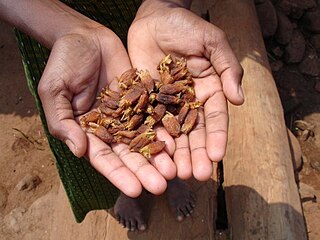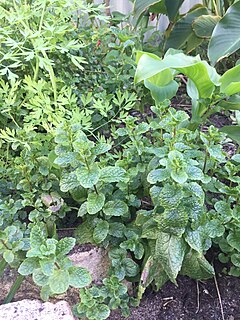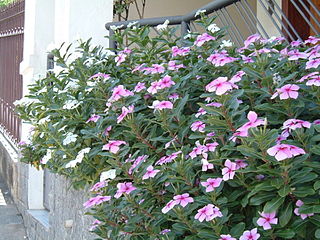
In botany and dendrology, a rhizome is a modified subterranean plant stem that sends out roots and shoots from its nodes. Rhizomes are also called creeping rootstalks or just rootstalks. Rhizomes develop from axillary buds and grow horizontally. The rhizome also retains the ability to allow new shoots to grow upwards.

Liquorice or licorice is the common name of Glycyrrhiza glabra, a flowering plant of the bean family Fabaceae, from the root of which a sweet, aromatic flavouring can be extracted. The liquorice plant is a herbaceous perennial legume native to the Western Asia and southern Europe. It is not botanically related to anise, star anise, or fennel, which are sources of similar flavouring compounds. Liquorice is used as a flavouring in candies and tobacco, particularly in some European and West Asian countries.

Salvia officinalis is a perennial, evergreen subshrub, with woody stems, grayish leaves, and blue to purplish flowers. It is a member of the mint family Lamiaceae and native to the Mediterranean region, though it has naturalized in many places throughout the world. It has a long history of medicinal and culinary use, and in modern times as an ornamental garden plant. The common name "sage" is also used for a number of related and unrelated species.

Herbal medicine is the study of botany and the use of medicinal plants. Plants have been the basis for medical treatments through much of human history, and such traditional medicine is still widely practiced today. Modern medicine makes use of many plant-derived compounds as the basis for evidence-based pharmaceutical drugs. Although herbalism may apply modern standards of effectiveness testing to herbs and medicines derived from natural sources, few high-quality clinical trials and standards for purity or dosage exist. The scope of herbal medicine is sometimes extended to include fungal and bee products, as well as minerals, shells and certain animal parts.

Traditional medicine comprises medical aspects of traditional knowledge that developed over generations within various societies before the era of modern medicine. The World Health Organization (WHO) defines traditional medicine as "the sum total of the knowledge, skills, and practices based on the theories, beliefs, and experiences indigenous to different cultures, whether explicable or not, used in the maintenance of health as well as in the prevention, diagnosis, improvement or treatment of physical and mental illness". Traditional medicine is contrasted with scientific medicine.

Medicinal plants, also called medicinal herbs, have been discovered and used in traditional medicine practices since prehistoric times. Plants synthesise hundreds of chemical compounds for functions including defence against insects, fungi, diseases, and herbivorous mammals. Numerous phytochemicals with potential or established biological activity have been identified. However, since a single plant contains widely diverse phytochemicals, the effects of using a whole plant as medicine are uncertain. Further, the phytochemical content and pharmacological actions, if any, of many plants having medicinal potential remain unassessed by rigorous scientific research to define efficacy and safety.

Phytochemistry is the study of phytochemicals, which are chemicals derived from plants. Those studying phytochemistry strive to describe the structures of the large number of secondary metabolic compounds found in plants, the functions of these compounds in human and plant biology, and the biosynthesis of these compounds. Plants synthesize phytochemicals for many reasons, including to protect themselves against insect attacks and plant diseases. Phytochemicals in food plants are often active in human biology, and in many cases have health benefits. The compounds found in plants are of many kinds, but most are in four major biochemical classes, the alkaloids, glycosides, polyphenols, and terpenes.

Pin Valley National Park is a National park of India located within the Lahaul and Spiti district, in the state of Himachal Pradesh, in far northern India.
Wildcrafting is the practice of harvesting plants from their natural, or 'wild' habitat, primarily for food or medicinal purposes. It applies to uncultivated plants wherever they may be found, and is not necessarily limited to wilderness areas. Ethical considerations are often involved, such as protecting endangered species, potential for depletion of commonly held resources, and in the context of private property, preventing theft of valuable plants, for example, ginseng.

Mugwort is a common name for several species of aromatic flowering plants in the genus Artemisia. In Europe, mugwort most often refers to the species Artemisia vulgaris, or common mugwort. While other species are sometimes referred to by more specific common names, they may be called simply "mugwort" in many contexts.

"Jawaharlal Nehru Tropical Botanic Garden and Research Institute", renamed in the fond memory of visionary Prime Minister of India Shri Pandit Jawaharlal Nehru is an autonomous Institute established by the Government of Kerala on 17 November 1979 at Thiruvananthapuram, the capital city of Kerala. It functions under the umbrella of the Kerala State Council for Science, Technology and Environment (KSCSTE), Government of Kerala. The Royal Botanic Gardens (RBG), Kew played an exemplary and significant role in shaping and designing the lay out of the JNTBGRI garden in its formative stages.

Non-timber forest products (NTFPs), also known as non-wood forest products (NWFPs),minor forest produce, special, minor, alternative and secondary forest products, are useful substances, materials and/or commodities obtained from forests which do not require harvesting (logging) trees. They include game animals, fur-bearers, nuts, seeds, berries, mushrooms, oils, sap, foliage, pollarding, medicinal plants, peat, mast, fuelwood, fish, spices, and forage.
Yusuf ibn Ismail al-Kutubi known as Ibn al-Kabir a scholar and physician worked as a doctor in the palaces of the Abbasid caliphs in Baghdad. He was born in Khoy in Iran.

In general use, herbs are plants with savory or aromatic properties that are used for flavoring and garnishing food, for medicinal purposes, or for fragrances; excluding vegetables and other plants consumed for macronutrients. Culinary use typically distinguishes herbs from spices. Herbs generally refers to the leafy green or flowering parts of a plant, while spices are usually dried and produced from other parts of the plant, including seeds, bark, roots and fruits.

Gandhamardan Hills or Gandhamardan parbat is a hill located in between Balangir and Bargarh district of Odisha, India. This hill is well known for medicinal plants. There is a Bauxite reserve which is planned for exploration by the state government through a private venture.

Dominican tea culture combines many customs adapted from various colonial and immigrant cultures that have mingled in Dominica. "Bush teas", made from local herbal plants and often taken for medicinal purposes, are a traditional part of Dominica's culture.

Coclaurine is a nicotinic acetylcholine receptor antagonist which has been isolated from a variety of plant sources including Nelumbo nucifera, Sarcopetalum harveyanum, Ocotea duckei, and others. It belongs to the class of tetrahydroisoquinoline alkaloids. Dimerization of coclaurine leads to the biscoclaurine alkaloids such as cepharanthine.
Aromatic and Medicinal Plants Research Station, Odakkali is a research Station under the Central Zone of Kerala Agricultural University at Odakkali in Ernakulam district of Kerala, India. This station was established in 1951 as Lemongrass Breeding Station by the Travancore-Cochin Government. Later in 1972 after the formation of Kerala Agricultural University the research station was brought under the control of KAU. The station was renamed as Aromatic and Medicinal Plants Research Station (AMPRS) in 1982.

Arya Vaidya Sala, popularly known as Kottakkal Arya Vaidya Sala, is a healthcare centre located in Kottakkal, in the Indian state of Kerala, known for its heritage and expertise in the Indian traditional medicine system of Ayurveda.

Bibi Ameenah Firdaus Gurib-FakimGCSK is a Mauritian politician and biodiversity scientist who served as the 6th President of Mauritius from 2015 to 2018. In December 2014, she was selected to be the presidential candidate of the Alliance Lepep. After Kailash Purryag resigned on 29 May 2015, both Prime Minister Sir Anerood Jugnauth and Leader of the Opposition Paul Berenger positively welcomed her nomination, which was unanimously approved in a vote in the National Assembly.
















